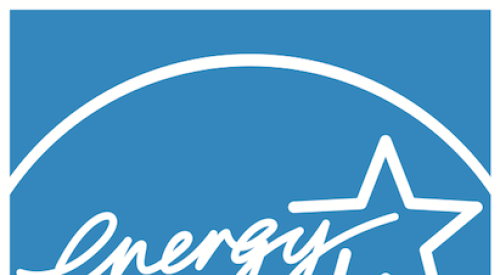No one in Florida questions the value of Energy Star, the U.S. Environmental Protection Agency’s landmark voluntary program to improve energy efficiency in new housing built across America. In fact, Florida may be the brightest light in Energy Star’s nationwide galaxy. But builders trying to get Energy Star certification in many states may soon be caught in the fallout from a dispute between EPA and the Florida agencies licensing home energy raters - the technicians who test homes for compliance with Energy Star performance standards.
| Spain Construction built this Energy Star home in Gainesville, Fla. for 1999 Parade of Homes. It is 3556 sq. ft., sells for $345,000. |
To be certified under the Energy Star program, a home must achieve a score of 86 on the national Home Energy Rating System (HERS). In HERS scoring, houses that meet the minimum national standard for energy efficiency are rated at 80. A perfect score of 100 would signify a house that consumes no energy at all. From the beginning, Energy Star has had a target of 30% greater efficiency than the minimum standard. And Energy Star has always been a performance-based program. Builders can employ any method to reduce energy use, as long as the housing product tests to a HERS score of 86 or higher.
The current dispute took shape when Venture Associates, an Ocala, Fla.-based developer of a large, production-built community, Ocala Palms, was allowed by EPA to employ the Builder Option Package (BOP). This is a recent innovation which allows batch testing of a random sample of one house out of every seven built, rather than testing each house individually, to qualify for Energy Star certification.
EPA developed the BOP to attract more production builders into the Energy Star program, and to make the program viable in the 30 states with limited access to trained home energy raters. "By offering BOPs and the sample testing protocol, our program aligns better with the way production builders actually do business, says Sam Rashkin, EPA’s manager of the Energy Star program. "They want an energy spec for a whole subdivision. They can’t put different windows on one house because it has a more demanding solar orientation. BOP is a prescriptive solution. But BOPs were never intended for use in states with robust energy rating systems.
However, Florida has just such a system. In 1993, that state passed a law establishing a uniform building-rating system and licensing of home energy raters to test buildings according to approved tools and protocols. Florida’s Department of Community Affairs (DCA) administers the law. DCA contracted Florida Solar Energy Center (FSEC), a state energy research institute, to train and test home energy raters.
"We’ve trained close to 500 raters," says Philip Fairey, deputy director of FSEC, "and 200 of them are active in the field right now."
The Florida rating system is similar to HERS, but slightly different. "Florida’s legislation requires that the state ratings system be consistent with the state energy code," says Fairey. "But it is also required to align, as much as possible, with national standards. And we’ve done that. We’ve compared results from the software we use in Florida with those from other tools used in ratings elsewhere and always gotten very similar results."
Ocala Palms wanted to qualify its 1600 homes under a BOP to control costs. "We recognize the marketing advantages that come with Energy Star certification," Venture Associates purchasing agent David Voight told Energy Design Update, a New Hampshire-based newsletter, "but [testing each house individually]" that’s a horrendous expense to bear."
Home energy rater Ken Fonorow, of Florida Home Energy & Resources Organization, says he quoted Ocala Palms a rate of $250 per house, if he had to drive from Newberry, Fla., west of Gainesville, to test each one. "My price is dependent on how many houses are ready to be checked at one time. It would be less if I could test four or five at once.'
Why EPA agreed to a BOP in Florida is a bigger mystery. Rashkin will only say, "Generally, we would not be doing a BOP in Florida. However, we grandfathered this particular developer because we agreed to allow them a BOP before we finalized the program. They wanted to be part of this testing protocol."
Rashkin defends the decision by asserting that batch testing is appropriate for production builders who build from energy-efficient designs and have good quality controls in place. He also says if any houses tested under a BOP fail to register a HERS score of 86, the builder is then required to test every house.
When rater Kik Koppitch of Gainesville Regional Utilities tested a number of models at Ocala Palms, several didn’t pass muster, scoring between 83 and 85. Koppitch was then called to do more testing under the one-in-seven sampling protocol. He refused, saying he feared it would jeopardize his state license. Other raters, including Fonorow, also refused.
"From the rater’s standpoint, there’s real danger in using that sampling protocol," says Fonorow. "What if a house is batched in and then doesn’t perform? The rater could be held liable."
He remains adamant about not certifying any house that is not tested: "I will not certify six additional houses after rating one. You can make a case for a sampling protocol in manufactured housing, produced in a factory, but not for field-built product."
Unfortunately for Rashkin and EPA, Fairey says the 1993 Florida law dictates raters must test every house they certify with a score: "We tell the raters that the only place their license is in jeopardy is if they provide a rating for a house they haven’t tested. If they send in information on houses they haven’t rated, that’s fraud.
If EPA wants to use a sampling protocol and have the rater test one of every seven houses, and send that form to EPA, there’s nothing wrong with that. But it has to be EPA that certifies the other six houses. Sam (Rashkin) can’t expect our rater to put his good name on the line by saying the other six are as good as the one he tested.
There’s no mechanism in Florida for doing a sampling protocol, or BOP, and calling it a rating.
EPA is looking for shortcuts. The trouble is, they may get more houses qualified, but they are not coming up to the bar they established for themselves. The problem is, the prescriptive standards in the BOP are not set high enough to reach a HERS score of 86. That’s lowering the bar. Sam can give Energy Star certificates to homes because they have red chimneys, if he wants. It’s his program. But from what we can see, the prescriptive standards don’t consistently achieve a HERS score of 86.
"From our standpoint, the real client should be the consumer - the home buyer - not the builder. We think the best way to protect the home buyer is through performance verification, one house at a time," Fairey concludes.
The trouble with this little turf war is there are builders on both sides, in Florida and around the country. If Fairey and his raters are right about the inability of EPA’s Builder Option Packages to consistently reach the bar at a HERS score of 86, the entire Energy Star program may be jeopardized in those states without mature home energy rating programs, and that includes some big housing states - notably Texas and Arizona.
However, the jury is still out on whether the experiences of builders using BOPs to seek Energy Star certification elsewhere in the country are as negative as in Florida. "We’re using a BOP with good results," says Cedar Rapids, Iowa, builder Drew Skogman. He’ll build 130 houses this year, priced from $170,000 to $350,000. And he expects to certify all of them.
"They have a rater hired by our utility - Mid-American Energy - do spot-checks once a month," says Skogman. "We send in plans and specs and they do another 10 or 11 houses a month from them. There’s no state-mandated rating system.
"When we started last year, we had one or two models that were not testing out to HERS 86. But Mid-American worked with us to find out where the problems were. We corrected that, and then we checked those models on a more frequent basis. Since then, our on-site ratings have been coming in higher than off plans," says Skogman.
Perhaps surprisingly, balmy Gainesville, Fla., is a hotbed of Energy Star activity. Gainesville builder Tom Spain does 12 to 14 luxury homes a year, priced $250,000 to $700,000. Most of them are Energy Stars. "I ask my buyers, ‘Why compromise the potential of a $300,000 house to save $300 on a blower-door test?’ Occasionally, I have a buyer who says no-usually because they plan to sell the house again within three years, but 85% to 90% of buyers want it.
"The marketing value is very strong. On a 3000-square foot house, we do a full package for about $4000, including low-E insulated glass windows, sealed ductwork, radiant barrier, and upgraded air conditioning. But they average $75 a month in energy savings. If we’re dealing with experienced buyers who are college-educated, they almost always see the value in that, especially since so many of them plan to stay in the house for 10 to 15 years."












